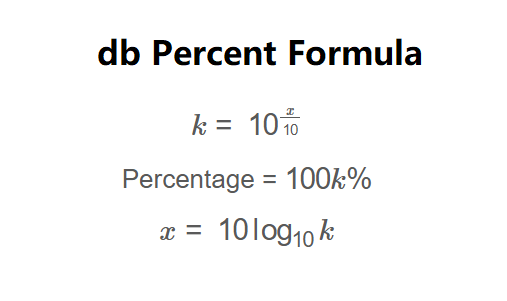 Home
Home
 Back
Back

Definition: This converter transforms a power level in decibels (dB) to a percentage and vice versa. Decibels are a logarithmic unit used to express the ratio of two power levels, while the percentage represents the linear scale factor as \( 100k\% \).
Purpose: Engineers, audio professionals, and scientists use this tool to convert between dB and percentage scales, which is useful in signal processing, audio engineering, telecommunications, and acoustics for interpreting power levels.
The converter uses the following formulas, as shown in the image above:
\( k = 10^{\frac{x}{10}} \)
Percentage = \( 100k\% \)
\( x = 10 \log_{10} k \)
Where:
Steps:
Converting between dB and percentage is essential for:
Example 1: Convert 50% to dB:
Q: How accurate is the dB to percent conversion?
A: The conversion is mathematically exact, using the precise formulas. However, rounding errors may occur due to the formatting of results to 4 decimal places or scientific notation for very small values.
Q: Why can’t I enter both dB and percentage at the same time?
A: The converter is designed to perform a one-way conversion (dB to percent or percent to dB) to avoid ambiguity. Select the conversion type to specify the input.
Q: What does a negative dB value mean?
A: A negative dB value indicates a power level less than the reference level (i.e., \( k < 1 \)), corresponding to a percentage less than 100%. For example, -3 dB corresponds to approximately 50%.